Beyond Qafila Thania is a collaborative research project including a ten – day walk between M’Hamid and Tisent (200 km) through the Sahara in the South of Morocco. The walk was instigated as a methodology to actively approach the cultural, social and geopolitical space of the desert while tracing back the history of the caravans and its influence in current day cultures and societies.
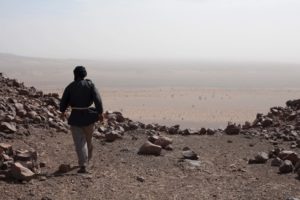
Our group included artists Amado Alfadni (Egypt) and M’Barek Bouhchichi (Morocco), researcher Pau Cata and architect Carlos Perez Marin (Spain), the team of our guide Said with Mohammed, Sjeigh and Abdu, and five camels to carry our luggage. All of us were engaged in research topics related to the desert as a space; from contemporary nomad cultures to the history of slave trade, the concept of blackness and the mobility of knowledge within the Mediterranean, the Maghreb and West Africa. My focus was to approach through the dimension of nature, the different landscapes tracing back the social, cultural and political ecology of the oases.
The project consisted of different stages. The first week we went to the Draa valley in company of artists and curators Olì Bonzanigo (Italy), Laila Hida (Morocco), Francesca Masoero (Italy) and Leire Vergara (Spain), to visit the oases, kasbahs and ksours of Tamnougalt, Tinzouline and Tamgroute. Here we learned about water distribution policies, its cultural heritage and current politics in The Draa valley, where, as in the wide region, water levels have dropped drastically during the last years. Every afternoon we initiated and recorded reading sessions and discussions concerning these subjects. This was a stimulating way to collect our thoughts and frame and extend ideas; a routine we continued during the journey in the desert. The trip ended with a visit to the Taragalte Festival in M’Hamid, a gathering of musicians from the Sahara region, Morocco, Algeria, Mauritania, Mali and Niger.
After the festival, it was time to start walking. Though we were all engaged in subjects concerning the desert, none of us, besides Carlos (who made a desert expedition the year before) knew what to expect from the challenges ahead. The daily schedule was to walk 5 hours. Around midday we’d take rest in the shade of a tree while Said and his crew build a fire and prepared lunch. Accordingly we’d continue to finally stop just before dark to make camp for the night. This didn’t sound too enduring and we were eager to begin. No surprise curiosity killed the cat. During these ten days, keeping up with the fast pace of the group while concentrating where to place your feet, next to blisters, burning heat and cold windy nights, allowed little romancing over the astonishing landscapes we were moving through. We were getting used to a rhythm of life outside, and our focus became more practically oriented to navigate the desert space. Which was in retrospect a fascinating learning curve altogether.
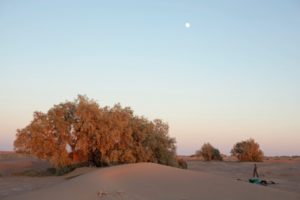
We came to understand that the acacia trees providing us shelter at midday, are local meeting points for people in the region who know every tree by heart. Said, Sjeigh and Mohammed coming from different tribes, told us about the names of empty planes, rock formations, riverbeds and hills we passed through, and some stories and historic events that took place there. Furthermore the journey was aligned along places where we could possibly find water for the camels, and wood to build a fire to cook and stay warm in the evening. Bread was baked in the ashes in the sand. There were many traces. Some days the ground was scattered with ancient pieces of ceramics or fossils. One afternoon in the middle of sand dunes, we passed the remains of an old souk and a slave market that was in function only 40 years ago. We also passed ruins of settlements and graveyards partly exposed because the sand and the general surroundings are always moving. On the 8th day we came upon a village and a marabout, after which we shared a meal with a nomad family we met on our way.
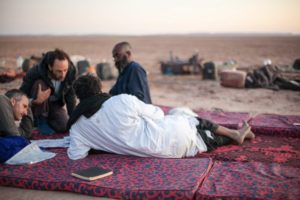
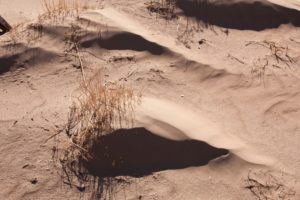
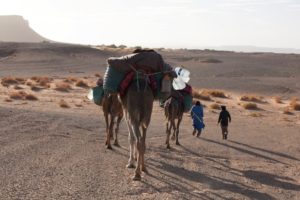
As a practice, the walk made us encounter the desert both as site and (intimate) space. In fact desert does not exist in Moroccan Arabic, Berber or Saharouian languages. Its space contains a multitude of landscapes, each with its own description and references. Moving through it together functioned as a catalyst to look in new ways at our surroundings and at ourselves. The afternoon discussions in that sense furthered this concentrated exchange of observations and perspectives, driving ideas into unexpected directions and insights. Physically and conceptually, the experiences and observations of the journey became tools to begin to understand the nature of its bases, an exceptional and altering experience that made us leave all pre-conceived ideas and positions behind. Effects which only recently start to unfold through a series of events and the development of new works to come.
Because Beyond Qafila Thania took place in collaboration with Qanat program, immediately after our return to Marrakech, a round table discussion was set up to share and discuss the project. One month later at December 15, we realized a sound installation of the recorded conversations, as participants in the group exhibition Between Wells Reloaded, at le18 in Marrakech. At the moment we are preparing a contribution to Qanat publication, and during the coming months I will continue to process the recorded video and sound documents concerning my investigation depicting the ecology of the oases. Beyond Qafila Thania was an intense and memorable research, which marked and moved my artistic work in new directions.
www.heidivogels.nl
www.gardensoffez.com
http://platformharakat.com/actions/beyond-qafila-thania
http://marsaddraa.weebly.com/
If you would like to partner with us as well, please contact us via info@rabbanifoundation.org

